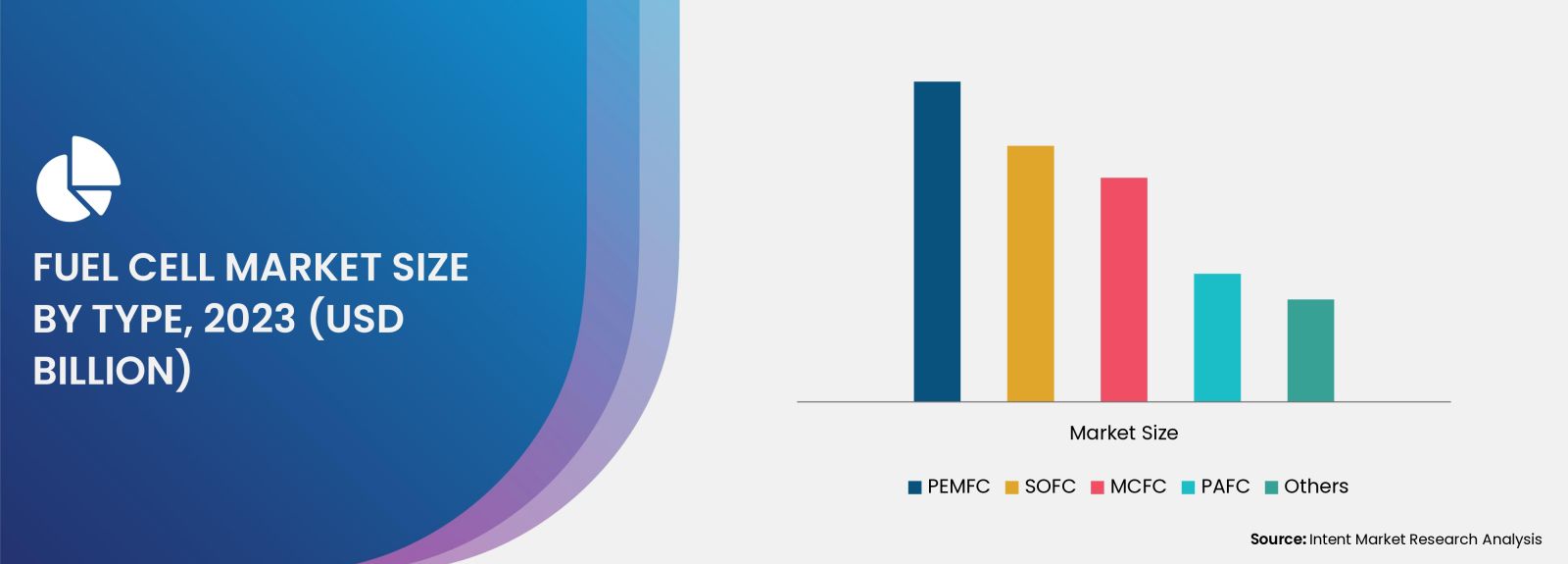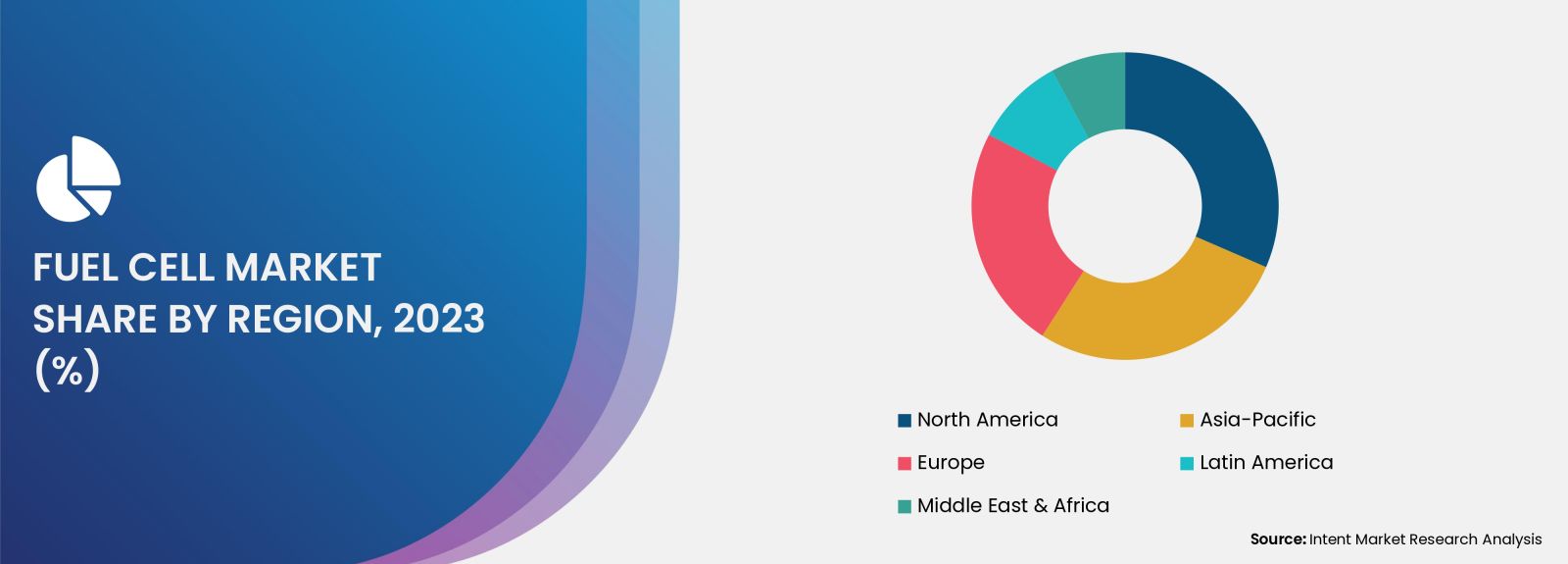sales@intentmarketresearch.com
+1 463-583-2713
Fuel Cell Market By Component (Stack, Balance of Plant (BOP)), By Type (PEMFC, SOFC, MCFC, PAFC), By Application (Transportation, Stationary Power, Portable Power), and By Region; Global Insights & Forecast (2024 – 2030)
As per Intent Market Research, the Fuel Cell Market was valued at USD 3.8 billion in 2023 and will surpass USD 13.4 billion by 2030; growing at a CAGR of 19.6% during 2024 - 2030.
Proton Exchange Membrane Fuel Cells (PEMFC) are Anticipated to Grow the Fastest
Proton Exchange Membrane Fuel Cells (PEMFC) are anticipated to grow the fastest in the Fuel Cell Market, mainly due to their versatility and widespread use in transportation and stationary power applications. PEMFCs are lightweight, compact, and offer high power density, making them ideal for use in vehicles, such as fuel cell electric vehicles (FCEVs), buses, and trucks. These fuel cells operate at lower temperatures compared to other types, which allows for faster start-up times, making them suitable for automotive applications.
The growth of PEMFCs is also supported by increasing government investments in hydrogen infrastructure, particularly in regions like Asia-Pacific, Europe, and North America. As more automotive manufacturers, such as Toyota, Hyundai, and Honda, roll out hydrogen-powered vehicles, the demand for PEMFCs is expected to surge. Additionally, the ability of PEMFCs to provide clean, reliable energy in stationary power generation applications further boosts their market potential.

Asia-Pacific is Projected to Have the Largest Market Size During the Forecast Period
Asia-Pacific holds the largest market share in the Fuel Cell Market, driven by the significant adoption of fuel cell technology in countries like Japan, South Korea, and China. The region is a leader in hydrogen infrastructure development, with Japan and South Korea making substantial investments to promote the use of hydrogen fuel cells across industries. These countries have ambitious goals to transition to hydrogen economies, with widespread adoption of fuel cell vehicles and hydrogen-powered public transportation systems.
In China, the government’s push toward reducing emissions and promoting clean energy technologies has led to increased investments in fuel cell technology, particularly for heavy-duty transportation and industrial applications. The region's focus on renewable energy solutions and the development of hydrogen refueling infrastructure further boosts its position as the largest market for fuel cells. With continued investment in hydrogen and fuel cell technologies, Asia-Pacific is expected to maintain its dominance in the global market.

The report focuses on estimating the current market potential in terms of the total addressable market for all the segments, sub-segments, and regions. In the process, all the high-growth and upcoming technologies were identified and analyzed to measure their impact on the current and future market. The report also identifies the key stakeholders, their business gaps, and their purchasing behavior. This information is essential for developing effective marketing strategies and creating products or services that meet the needs of the target market. The report also covers a detailed analysis of the competitive landscape which includes major players, their recent developments, growth strategies, product benchmarking, and manufacturing operations among others. Also, brief insights on start-up ecosystem and emerging companies is also included as part of this report.
Report Objectives:
The report will help you answer some of the most critical questions in the Fuel Cell Market. A few of them are as follows:
- What are the key drivers, restraints, opportunities, and challenges influencing the market growth?
- What are the prevailing technology trends in the Fuel Cell Market?
- What is the size of the Fuel Cell Market based on segments, sub-segments, and regions?
- What is the size of different market segments across key regions: North America, Europe, Asia-Pacific, Latin America, Middle East & Africa?
- What are the market opportunities for stakeholders after analyzing key market trends?
- Who are the leading market players and what are their market share and core competencies?
- What is the degree of competition in the market and what are the key growth strategies adopted by leading players?
- What is the competitive landscape of the market, including market share analysis, revenue analysis, and a ranking of key players?
Report Scope:
|
Report Features |
Description |
|
Market Size (2023) |
USD 3.8 billion |
|
Forecasted Value (2030) |
USD 13.4 billion |
|
CAGR (2024 – 2030) |
19.6% |
|
Base Year for Estimation |
2023 |
|
Historic Year |
2022 |
|
Forecast Period |
2024 – 2030 |
|
Report Coverage |
Market Forecast, Market Dynamics, Competitive Landscape, Recent Developments |
|
Segments Covered |
Fuel Cell Market By Component (Stack, Balance of Plant (BOP)), By Type (PEMFC, SOFC, MCFC, PAFC), and By Application (Transportation, Stationary Power, Portable Power) |
|
Regional Analysis |
North America (US, Canada, Mexico), Europe (Germany, France, UK, Italy, Spain, and Rest of Europe), Asia-Pacific (China, Japan, South Korea, Australia, India, and Rest of Asia-Pacific), Latin America (Brazil, Argentina, and Rest of Latin America), Middle East & Africa (Saudi Arabia, UAE, Rest of Middle East & Africa) |
|
Customization Scope |
Customization for segments, region/country-level will be provided. Moreover, additional customization can be done based on the requirements |
|
1. Introduction |
|
1.1. Market Definition |
|
1.2. Scope of the Study |
|
1.3. Research Assumptions |
|
1.4. Study Limitations |
|
2. Research Methodology |
|
2.1. Research Approach |
|
2.1.1. Top-Down Method |
|
2.1.2. Bottom-Up Method |
|
2.1.3. Factor Impact Analysis |
|
2.2. Insights & Data Collection Process |
|
2.2.1. Secondary Research |
|
2.2.2. Primary Research |
|
2.3. Data Mining Process |
|
2.3.1. Data Analysis |
|
2.3.2. Data Validation and Revalidation |
|
2.3.3. Data Triangulation |
|
3. Executive Summary |
|
3.1. Major Markets & Segments |
|
3.2. Highest Growing Regions and Respective Countries |
|
3.3. Impact of Growth Drivers & Inhibitors |
|
3.4. Regulatory Overview by Country |
|
4. Fuel Cell Market, by Component (Market Size & Forecast: USD Million, 2022 – 2030) |
|
4.1. Stack |
|
4.2. Balance Of Plant (BOP) |
|
5. Fuel Cell Market, by Type (Market Size & Forecast: USD Million, 2022 – 2030) |
|
5.1. Proton Exchange Membrane Fuel Cells (PEMFC) |
|
5.2. Solid Oxide Fuel Cells (SOFC) |
|
5.3. Molten Carbonate Fuel Cells (MCFC) |
|
5.4. Phosphoric Acid Fuel Cells (PAFC) |
|
5.5. Others |
|
6. Fuel Cell Market, by Application (Market Size & Forecast: USD Million, 2022 – 2030) |
|
6.1. Transportation |
|
6.1.1. Passenger Vehicles |
|
6.1.2. Commercial Vehicles |
|
6.1.3. Marine |
|
6.1.4. Aviation |
|
6.2. Stationary Power |
|
6.2.1. Residential |
|
6.2.2. Commercial |
|
6.2.3. Industrial |
|
6.2.4. Data Centers |
|
6.2.5. Utilities |
|
6.3. Portable Power |
|
6.4. Others |
|
7. Regional Analysis (Market Size & Forecast: USD Million, 2022 – 2030) |
|
7.1. Regional Overview |
|
7.2. North America |
|
7.2.1. Regional Trends & Growth Drivers |
|
7.2.2. Barriers & Challenges |
|
7.2.3. Opportunities |
|
7.2.4. Factor Impact Analysis |
|
7.2.5. Technology Trends |
|
7.2.6. North America Fuel Cell Market, by Component |
|
7.2.7. North America Fuel Cell Market, by Type |
|
7.2.8. North America Fuel Cell Market, by Application |
|
7.2.9. By Country |
|
7.2.9.1. US |
|
7.2.9.1.1. US Fuel Cell Market, by Component |
|
7.2.9.1.2. US Fuel Cell Market, by Type |
|
7.2.9.1.3. US Fuel Cell Market, by Application |
|
7.2.9.2. Canada |
|
7.2.9.3. Mexico |
|
*Similar segmentation will be provided for each region and country |
|
7.3. Europe |
|
7.4. Asia-Pacific |
|
7.5. Latin America |
|
7.6. Middle East & Africa |
|
8. Competitive Landscape |
|
8.1. Overview of the Key Players |
|
8.2. Competitive Ecosystem |
|
8.2.1. Level of Fragmentation |
|
8.2.2. Market Consolidation |
|
8.2.3. Product Innovation |
|
8.3. Company Share Analysis |
|
8.4. Company Benchmarking Matrix |
|
8.4.1. Strategic Overview |
|
8.4.2. Product Innovations |
|
8.5. Start-up Ecosystem |
|
8.6. Strategic Competitive Insights/ Customer Imperatives |
|
8.7. ESG Matrix/ Sustainability Matrix |
|
8.8. Manufacturing Network |
|
8.8.1. Locations |
|
8.8.2. Supply Chain and Logistics |
|
8.8.3. Product Flexibility/Customization |
|
8.8.4. Digital Transformation and Connectivity |
|
8.8.5. Environmental and Regulatory Compliance |
|
8.9. Technology Readiness Level Matrix |
|
8.10. Technology Maturity Curve |
|
8.11. Buying Criteria |
|
9. Company Profiles |
|
9.1. Ballard Power Systems |
|
9.1.1. Company Overview |
|
9.1.2. Company Financials |
|
9.1.3. Product/Service Portfolio |
|
9.1.4. Recent Developments |
|
9.1.5. IMR Analysis |
|
*Similar information will be provided for other companies |
|
9.2. Bloom Energy |
|
9.3. Ceres Power |
|
9.4. Doosan Fuel Cell |
|
9.5. FuelCell Energy |
|
9.6. General Electric |
|
9.7. Horizon Fuel Cell |
|
9.8. Hydrogenics Corporation |
|
9.9. Nedstack Fuel Cell |
|
9.10. Nuvera Fuel Cells |
|
9.11. Panasonic |
|
9.12. Plug Power |
|
9.13. SFC Energy |
|
9.14. Toshiba |
|
9.15. Toyota |
|
10. Appendix |
Let us connect with you TOC
A comprehensive market research approach was employed to gather and analyze data on the Fuel Cell Market. In the process, the analysis was also done to analyze the parent market and relevant adjacencies to measure the impact of them on the Fuel Cell Market. The research methodology encompassed both secondary and primary research techniques, ensuring the accuracy and credibility of the findings.
.jpg)
Secondary Research
Secondary research involved a thorough review of pertinent industry reports, journals, articles, and publications. Additionally, annual reports, press releases, and investor presentations of industry players were scrutinized to gain insights into their market positioning and strategies.
Primary Research
Primary research involved conducting in-depth interviews with industry experts, stakeholders, and market participants across the Fuel Cell ecosystem. The primary research objectives included:
- Validating findings and assumptions derived from secondary research
- Gathering qualitative and quantitative data on market trends, drivers, and challenges
- Understanding the demand-side dynamics, encompassing end-users, component manufacturers, facility providers, and service providers
- Assessing the supply-side landscape, including technological advancements and recent developments
Market Size Assessment
A combination of top-down and bottom-up approaches was utilized to analyze the overall size of the Fuel Cell Market. These methods were also employed to assess the size of various subsegments within the market. The market size assessment methodology encompassed the following steps:
- Identification of key industry players and relevant revenues through extensive secondary research
- Determination of the industry's supply chain and market size, in terms of value, through primary and secondary research processes
- Calculation of percentage shares, splits, and breakdowns using secondary sources and verification through primary sources
.jpg)
Data Triangulation
To ensure the accuracy and reliability of the market size, data triangulation was implemented. This involved cross-referencing data from various sources, including demand and supply side factors, market trends, and expert opinions. Additionally, top-down and bottom-up approaches were employed to validate the market size assessment.
Available Formats


